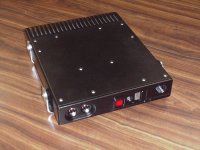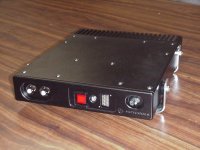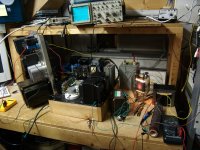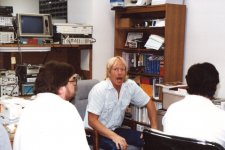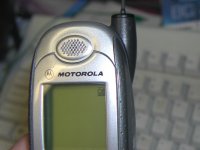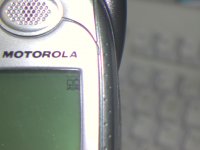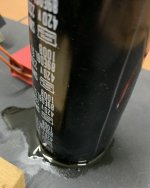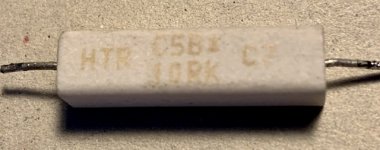But, it's how the world works. It needs thickheads too.
So does a good engineering team. A good team has people, all called engineers, with a widely varying skill set. There was a guy in my department who criticized me for spending most of my time actually building prototypes to prove that something actually works. He argued that good simulations are all that is needed...…
Here we LISTEN to real hardware. Pretty paper adverts or fancy Powerpoint slides have no "sound." They will rarely convince us to buy something without other influences.....Real product in front of our faces and ears is the best influencer.
Our research department designed circuits, parts, concepts, or algorithms for the product groups to make into radio products. We, like all the outside vendors need to convince them to use our chips over choices from Qualcomm or TI.
Maybe 15 years ago there was a major upper management shake up in the Chicago HQ. The new business owner of the research group made it known that he was coming to Florida, and EVERY person in his organization had to do a brief presentation to justify their jobs. Two groups were being merged, and people WERE going to lose their jobs.
All useful work ceased and a major panic ensued. Good friends suddenly were at odds with each other. Engineers vanished into dark corners with laptops to make real flashy Powerpoint presentations with overly exaggerated claims about their worth to the company. I just went on about my daily routine, unfazed. Several people wondered why I wasn't making a presentation. I replied that I didn't need one, and my pitch for continued employment would be about 10 seconds long.
When the big day came. The highly paid heavy hitters went first in the morning. I didn't even attend the morning presentation.
When I was up, I walked into the room with a large metal brick in my hand. From a few feet away I tossed the 6 pound brick on the wooden table, which immediately got everyone's attention. I stated that it was the first and only prototype for a high speed data radio that would be a shipping product in the following year, I designed the 90 watt transmitter, aggregated all the radio schematics from the other designers, laid out the PC board, got the chassis machined and painted in house, got 5 boards made in house, ordered all the unique parts, got the boards assembled on our SMD line, tested and took data on all 5, then assembled this prototype and prepared a 24 page report that details the performance to specifications. ANY QUESTIONS? There were none, and I kept my job for 10 more years.
Apparently, it will destroy "your mom"...
There was this equation from that Physics class that I slept through which would define just what these things can destroy.....something like 1/2 CV squared......it's that squared thing that creates all the fun.
In one of my many exploits at Motorola I had to redesign a SCADA system that ran wires underground to sensors and connected them to a microprocessor. We lived and worked in Florida, the lightning capital of North America. These things blew up a lot. Field failure rates were like 8% per year. I get to solve that problem.....How do you test for lightning resistance? You need to make some!
A friend in the medical electronics got me an old defibrillator. These things charge that big square cap seen behind the glowing 833A up to about 6500 volts, then discharge it through a big air core inductor into the patient's chest. The inductor controls the discharge rate to something that prevents blowing the patient in half, so we bypassed it.
After solving the lightning issue with the product, the defib had no real purpose, but we used it for educational experiences when the bosses weren't there. In our last such experience we learned that firing this device with the test leads connected to a banana results in several hours of cleaning yellow goo off the ceiling. The 16uF 7.5 KV cap came home with me, and was used in the 833A test amp. The remainder of the defib got scrapped.
Attachments
Florida Lightning Model
Spending the first 62 years of my life in Florida, being zapped a couple times, and knocked to the ground dazed once by nearby lightning strikes taught me a bit about lightning.
A strike 1/4 mile away will create a momentary gradient across the ground of hundreds of volt per foot. Standing barefoot on wet ground can be a shocking experience when lightning hits a power pole a block away.
I had an old Hallicrafters shortwave radio when I was a kid. It was grounded to a water pipe, and had a random wire antenna strung between two trees. I woke up in the middle of the night once to see white flashes coming from the inside of the radio. These were discharges from the antenna circuit to ground, so I began disconnecting the antenna when the radio was not in use.
One afternoon during a storm, I watched a 3 or 4 inch spark jump from that antenna wire to an electric drill that was plugged in, so I began tossing the antenna wire out the window when the radio was not in use.
One of the big problems with that SCADA system was the habit of grounding the long sensor cables at each end. We saw cables blown in half from a strike on the power poles on the other side of the golf course from the local test system.
The system was designed to endure a direct connection from any input or output to line voltage, and accept any transient dealt out by the line voltage transient tester that Motorola had in the main plant.
Clearly this wasn't adequate, so I came up with a circuit that would withstand a single hit from the defib at full power (400 joules) without damage. The resulting heat needed to be dissipated before it would withstand a second blast (2 or 3 minutes), but this was enough to reduce an 8% field failure rate to under 1%.
It wasn't a presentation seen by many. You don't last 41 years in the corporate world by launching missiles......you fly under the radar undetected and use stealth technology to expose those who screw up the system for their own gain.
I had a reputation for making prototypes that functioned properly on the first try. Every one of my "proof of concept" proto radios and phones were at least functional. They may not meet all the specs, but proved that the "concept" worked, and revealed the areas where more work is needed.
For this reason I was often loaned out to various research or product groups to design and make their prototypes. I had worked with this group before, but not with the two individuals that made this mess. I made it clear to my management that I would never do it again.
I made several of those, one for nearly every block in the radio. They were intended for one person so that he could do "his" job. I also CC'd them to my boss so he could see where my time was being spent. The software team depended on these accurately reflecting the hardware they would be seeing in a few months.
This one, however managed to get circulated by someone who worked on the project and had enough of the BS. An ugly blamestorming incident caused by someone who had been lying and falsifying data caused the project to be halted. A deeper look into previous projects revealed a similar pattern. Most of the guilty parties vanished in the next round of layoffs.
I had a reputation for making prototypes that functioned properly on the first try. Every one of my "proof of concept" proto radios and phones were at least functional. They may not meet all the specs, but proved that the "concept" worked, and revealed the areas where more work is needed.
For this reason I was often loaned out to various research or product groups to design and make their prototypes. I had worked with this group before, but not with the two individuals that made this mess. I made it clear to my management that I would never do it again.
I made several of those, one for nearly every block in the radio. They were intended for one person so that he could do "his" job. I also CC'd them to my boss so he could see where my time was being spent. The software team depended on these accurately reflecting the hardware they would be seeing in a few months.
This one, however managed to get circulated by someone who worked on the project and had enough of the BS. An ugly blamestorming incident caused by someone who had been lying and falsifying data caused the project to be halted. A deeper look into previous projects revealed a similar pattern. Most of the guilty parties vanished in the next round of layoffs.
@Tubelab - "In one of my many exploits at Motorola"
Always an entertaining and fun read! Love it when I stumble upon a bunch of replies (like the ones you've written here) when checking out random threads that look interesting.
Sounds like you've had an electrically "rich life" so far - keep 'em coming!
Always an entertaining and fun read! Love it when I stumble upon a bunch of replies (like the ones you've written here) when checking out random threads that look interesting.
Sounds like you've had an electrically "rich life" so far - keep 'em coming!
Gosh, I feel like an old fuddy-duddy reading this thread. I work alone in a shop these days, and mostly all I do is sit around and fix stuff. Boring! But back in the day when there were 2 or 3 techs hanging around, we were a lot more "creative."
Once we had a collection (a dozen or so) of old 15" woofers from a decommissioned church organ. They all needed refoaming, but we had plenty of refoamed units in stock, so these were headed for the Dumpster. But before that, we laid them all out on the concrete shop floor, hooked them together with clip leads in some kind of series-parallel arrangement, and plugged the whole thing into an AC outlet. The resulting noise was so loud, it caused a small snowstorm of dust shaken loose from the steel roof trusses overhead! Then came the smoke & flames, and that acrid stench... Fun times.
Then there was this old no-name Italian combo organ that one of the sales crew had mistakenly taken in trade. It came back to the shop where it was quickly judged as beyond repair, and thereby condemned to death by misadventure. We placed it on the loading ramp out back, where our delivery driver carefully backed the 5-ton box truck on top of it, floored the gas & popped the clutch. The big rear duallies did a burnout on the poor little organ, immediately shredding it right down to the bottom of the case and sending parts flying into the parking lot. The power transformer shot out and struck the cinder block apron of the loading dock, leaving a big divot that is visible from the street to this day, 35 years and several coats of paint later. We're just lucky it didn't ricochet through someone's windshield (or frontal lobe).
Another time, another junk organ: This was a large church model that needed some rendering before it would even fit in the Dumpster. The actual dismantling is another story (that one almost put my dumb *** in the ER), but before it went down the Green Mile, I decided on a little excommunication ceremony in the shop, involving a pentagram traced on the lid with lighter fluid. I'd just put the match to it and was quietly observing the solemn ritual, when the boss walked around the corner...
Our boss always reacted in the moment with much harumphing and finger-wagging, but these days he enjoys retelling these stories as much as anyone.
Once we had a collection (a dozen or so) of old 15" woofers from a decommissioned church organ. They all needed refoaming, but we had plenty of refoamed units in stock, so these were headed for the Dumpster. But before that, we laid them all out on the concrete shop floor, hooked them together with clip leads in some kind of series-parallel arrangement, and plugged the whole thing into an AC outlet. The resulting noise was so loud, it caused a small snowstorm of dust shaken loose from the steel roof trusses overhead! Then came the smoke & flames, and that acrid stench... Fun times.
Then there was this old no-name Italian combo organ that one of the sales crew had mistakenly taken in trade. It came back to the shop where it was quickly judged as beyond repair, and thereby condemned to death by misadventure. We placed it on the loading ramp out back, where our delivery driver carefully backed the 5-ton box truck on top of it, floored the gas & popped the clutch. The big rear duallies did a burnout on the poor little organ, immediately shredding it right down to the bottom of the case and sending parts flying into the parking lot. The power transformer shot out and struck the cinder block apron of the loading dock, leaving a big divot that is visible from the street to this day, 35 years and several coats of paint later. We're just lucky it didn't ricochet through someone's windshield (or frontal lobe).
Another time, another junk organ: This was a large church model that needed some rendering before it would even fit in the Dumpster. The actual dismantling is another story (that one almost put my dumb *** in the ER), but before it went down the Green Mile, I decided on a little excommunication ceremony in the shop, involving a pentagram traced on the lid with lighter fluid. I'd just put the match to it and was quietly observing the solemn ritual, when the boss walked around the corner...
Our boss always reacted in the moment with much harumphing and finger-wagging, but these days he enjoys retelling these stories as much as anyone.
Last edited:
This is a picture from my desk when I worked in an off campus "think tank" around 1990. Note the "computer" on the riser between the RF signal generators.
It is a Vax-Mate 80286 machine made by Digital Equipment Corporation for use as a smart terminal on their Vax systems. It was a rather basic machine with limited memory and no hard drive, only a single 5 1/4 floppy drive. Many users learned to hate their Vax-Mates, and pranks could be played on unsuspecting users just by swapping out their DOS floppy disk with a "special edition."
Mine served a useful purpose operating the rack mounted POCSAG (paging) encoder on top of the RF signal generator to its right, and controlling some DIY hardware through its parallel printer port, which with some simple code could be used to send SPI data from a Lotus 123 spreadsheet (Hey, IBM was right down the street).
After two years in this secret warehouse location the facility was closed and moved into a larger more modern facility. The boss provided a large open top dumpster out in the loading bay where we were to toss all non-wanted equipment. I decided to keep my Vax-Mate, but most of the others were tossed, literally.
I had parked my van next to the building so that we could get to the roof, from there we got to the second story roof, and unwanted material was deposited into the dumpster below. It seems that one of the VAX-Mates experienced a rapid decomposition of it's CRT and we would spend a good part of the afternoon picking up glass in the dock area.
It is a Vax-Mate 80286 machine made by Digital Equipment Corporation for use as a smart terminal on their Vax systems. It was a rather basic machine with limited memory and no hard drive, only a single 5 1/4 floppy drive. Many users learned to hate their Vax-Mates, and pranks could be played on unsuspecting users just by swapping out their DOS floppy disk with a "special edition."
Mine served a useful purpose operating the rack mounted POCSAG (paging) encoder on top of the RF signal generator to its right, and controlling some DIY hardware through its parallel printer port, which with some simple code could be used to send SPI data from a Lotus 123 spreadsheet (Hey, IBM was right down the street).
After two years in this secret warehouse location the facility was closed and moved into a larger more modern facility. The boss provided a large open top dumpster out in the loading bay where we were to toss all non-wanted equipment. I decided to keep my Vax-Mate, but most of the others were tossed, literally.
I had parked my van next to the building so that we could get to the roof, from there we got to the second story roof, and unwanted material was deposited into the dumpster below. It seems that one of the VAX-Mates experienced a rapid decomposition of it's CRT and we would spend a good part of the afternoon picking up glass in the dock area.
Attachments
A careful look at the picture I recently posted revealed a faint image of the blue letters "IBM." I remember the box well, it was a retail box containing the latest (early) version of OS2. I got it from an IBM employee at the official meeting place for such exchanges, the Wendy's Hamburgers restaurant near the Boca IBM plant.
I was a beta tester for OS2 during it's development, I had an 80486 PC running a "hardware boot manager" with DOS / Windows V3, and two versions of OS2, released, and latest beta. It consisted of 3 small boot drives and a switch. My early testing involved an incident "that only an idiot (me) would do" prompted many discussions friendships, and unofficial product exchanges with several IBM people. The incident began like this:
Me....calling IBM's OS2 beta support line.
IBM..."OS2 beta support, how can I help you?"
Me....." I dragged the printer (icon) into the shredder (icon like the trash or Recycle bin) and I can't get it back."
IBM....."Why would you do that?"
Me....." To see what would happen."
A long discussion ensued that had me swapping through several floppy disks to reinstall the printer drivers. The next beta release would not allow dropping the printer or several other important things into the shredder without a multi step "do you really want to do this" dance.
This is probably where Microsoft learned (or stole) their similar Windows question.
I was a test system and fixture designer in the Cal lab at Motorola for several years. Most of my stuff went onto factory assembly and test lines for high volume production use. I learned early on to "always assume that your customer (line worker) was an untrained idiot until proven otherwise." That still didn't keep me from being that idiot some times. Some were even unofficially sanctioned.
We designed and built iDEN (Nextel, Mike, Clearnet....) phones. I was often given early prototypes of the latest phone to find their breaking points. There was no penalty for breaking a phone other than answering some questions about how it was broken, and how to best remedy the situation.
Some were simple software issues like this phone lock up where two battery icons, often with different levels were displayed and the phone became unresponsive. Some involved high RF exposure, like the rooftop antenna jungle on top pf the main plant, high EMF areas like the broken gate on the power company's HV substation. It was known that the iDEN system could become unusable under certain conditions where the phone was moving at high speed. It was determined experimentally that the real world limit for this was about 90 MPH travelling directly toward the cell tower. The DSP algorithm was modified to improve this.
Lets just say that gunshots were involved to better understand what happened when early vintage lithium polymer batteries were breached. Much milder official product tests were conducted based on some unofficial test results. Motorola was one of the last companies to use LIPO cells in their products due to some rather violent battery decompositions. LIPO tech has improved a lot in the nearly 20 years since these incidents happened.
So far today, and for the last 4 days I have been working with a hammer, and several other implements that are often used to break things. At this point in time, nothing has been destroyed, and I haven't incurred any blood loss yet.....I'm trying to build a home gym with old, recycled, and trashed parts.....and a few new ones. I'm not done yet, and my patience has been tested and nearly lost several times.
I was a beta tester for OS2 during it's development, I had an 80486 PC running a "hardware boot manager" with DOS / Windows V3, and two versions of OS2, released, and latest beta. It consisted of 3 small boot drives and a switch. My early testing involved an incident "that only an idiot (me) would do" prompted many discussions friendships, and unofficial product exchanges with several IBM people. The incident began like this:
Me....calling IBM's OS2 beta support line.
IBM..."OS2 beta support, how can I help you?"
Me....." I dragged the printer (icon) into the shredder (icon like the trash or Recycle bin) and I can't get it back."
IBM....."Why would you do that?"
Me....." To see what would happen."
A long discussion ensued that had me swapping through several floppy disks to reinstall the printer drivers. The next beta release would not allow dropping the printer or several other important things into the shredder without a multi step "do you really want to do this" dance.
This is probably where Microsoft learned (or stole) their similar Windows question.
I was a test system and fixture designer in the Cal lab at Motorola for several years. Most of my stuff went onto factory assembly and test lines for high volume production use. I learned early on to "always assume that your customer (line worker) was an untrained idiot until proven otherwise." That still didn't keep me from being that idiot some times. Some were even unofficially sanctioned.
We designed and built iDEN (Nextel, Mike, Clearnet....) phones. I was often given early prototypes of the latest phone to find their breaking points. There was no penalty for breaking a phone other than answering some questions about how it was broken, and how to best remedy the situation.
Some were simple software issues like this phone lock up where two battery icons, often with different levels were displayed and the phone became unresponsive. Some involved high RF exposure, like the rooftop antenna jungle on top pf the main plant, high EMF areas like the broken gate on the power company's HV substation. It was known that the iDEN system could become unusable under certain conditions where the phone was moving at high speed. It was determined experimentally that the real world limit for this was about 90 MPH travelling directly toward the cell tower. The DSP algorithm was modified to improve this.
Lets just say that gunshots were involved to better understand what happened when early vintage lithium polymer batteries were breached. Much milder official product tests were conducted based on some unofficial test results. Motorola was one of the last companies to use LIPO cells in their products due to some rather violent battery decompositions. LIPO tech has improved a lot in the nearly 20 years since these incidents happened.
So far today, and for the last 4 days I have been working with a hammer, and several other implements that are often used to break things. At this point in time, nothing has been destroyed, and I haven't incurred any blood loss yet.....I'm trying to build a home gym with old, recycled, and trashed parts.....and a few new ones. I'm not done yet, and my patience has been tested and nearly lost several times.
Attachments
I had just finished testing and adjusting my control and protection circuit. I was using a 9 volt battery to power the board. I disconnected the positive power lead but left the negative lead connected to the board. I was about done for the evening and poured a glass of whiskey (Maker's Mark on the rocks if you must know) and fired up a stogie. I started to think about what I was going to do the next day. I was looking at the smoke swirling off the stogie when I realized there was smoke coming from the board. I yanked the board off my MacGyver rig and realized the positive wire from the battery had been touching the bottom of the board. I touched the smoking transistor, a small signal TO-92 device, and it left a nasty burn on my finger that looks like a tattoo.
I figured that the transistor was the only device damaged (emitter connected to ground and positive wire apparently touched the collector lead) and replaced it. The circuit worked fine. The original transistor was completely shorted.
Edit: This proves what they said about me in high school: "Ed, Ed, the diode head. Cooks transistors till they're dead."
I figured that the transistor was the only device damaged (emitter connected to ground and positive wire apparently touched the collector lead) and replaced it. The circuit worked fine. The original transistor was completely shorted.
Edit: This proves what they said about me in high school: "Ed, Ed, the diode head. Cooks transistors till they're dead."
I had a 2200 uF 420 Volts capacitor leaking and becoming quite hot. Apparently it didn’t like the 450 Volts I was using for some time  .
.
My MOSFET powersupply was saved, because a series resistor failed as well and now had no resistance any more.
After replacing this capacitor and placing a new resistor it’s up and running again.
Regards, Gerrit
My MOSFET powersupply was saved, because a series resistor failed as well and now had no resistance any more.
After replacing this capacitor and placing a new resistor it’s up and running again.
Regards, Gerrit
Attachments
Last edited:
... darn fusible resistor!
When I was growing up in Florida, fireworks were illegal. Not jut in the cities, but it was a state law. They were unobtainium unless you went across the border. Parents were never going to be cooperative, and kind of hard to do on a 20” bike from the middle of the state. All the stores sold sparklers, but that was about it. You want something that goes BANG, right? So what to do on July 4? Capacitors can be had from discarded electronics. Passing just the right amount of AC through electrolytics makes something between a little Black Cat and an M-80.
When I was growing up in Florida, fireworks were illegal. Not jut in the cities, but it was a state law. They were unobtainium unless you went across the border. Parents were never going to be cooperative, and kind of hard to do on a 20” bike from the middle of the state. All the stores sold sparklers, but that was about it. You want something that goes BANG, right? So what to do on July 4? Capacitors can be had from discarded electronics. Passing just the right amount of AC through electrolytics makes something between a little Black Cat and an M-80.
When I was growing up in Florida, fireworks were illegal.
My bike ride would have been a bit longer.....I grew up in Miami.
Electrolytic caps in the wall outlet, been there blown that. They were especially useful on the end of a 100 foot extension cord for remote triggered bangs. Discarded AA and 9 volt batteries made a good bang too, sometimes.
You want something that goes BANG, right?
A 10 year old budding DIYer can make his own. Real powder could be sourced from bullets and shotgun shells. Make it go further with crushed sparklers and match heads. DIY "napalm" can be made by dissolving Styrofoam in gasoline, put that stuff in a closed container with a fuse......
The real fun started when one of my friends tricked his mother into buying him a 1/2 pound of saltpeter (Potassium Nitrate) for model rocketry of course.......
Science and evil little kids
Evil is such a strong word. I would describe my childhood as curious with a hint of mischievousness. No people or animals were harmed as a result of my antics, although the dog that raided our garbage at night was scared enough by exploding caps to pass our trash can by after a few incidents.
Evil would describe the kid that dumped a carton of BB's down the stairwell during class change in high school. Seven people were hurt enough to need a trip to the hospital, one with a fractured skull.
I school I blew up a toilet
Flushing a cherry bomb in a second floor bathroom in middle school sure surprised the people in the bathroom directly below.
My younger brother figured out that explosives were not needed for such mischief. Hence the invention of the synchronized flush. Flushing all the toilettes on the second floor simultaneously made for some serious overflow on the first floor. Not a good time to be sitting on the can in the first floor bathroom.
By this time my curious side had discovered aluminum cooking foil, kite string, and power lines!
- Home
- Member Areas
- The Lounge
- What did you destroy today?
